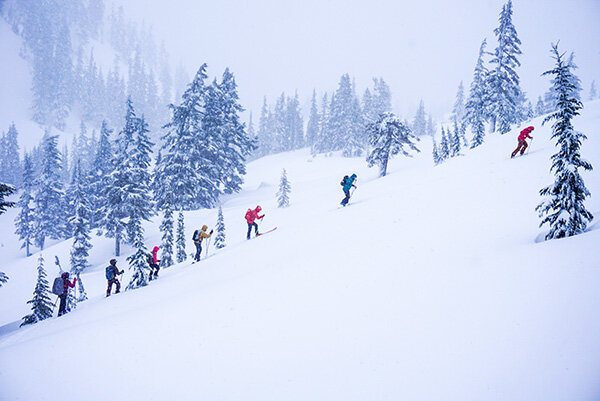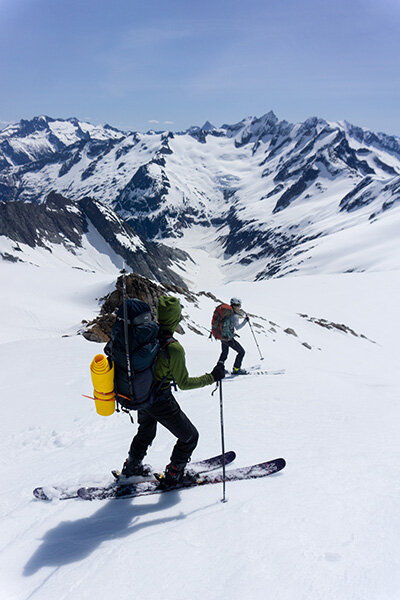 Backcountry skiers skin up Mt. Baker's Bagley Basin area.
Backcountry skiers skin up Mt. Baker's Bagley Basin area.The secret’s out, folks. Or has been out. Or was never a secret in the first place — depending on who you talk to. If you’ve noticed more skin-track traffic or jockeyed a little harder for trailhead parking this winter, you aren’t alone. No — you likely aren’t alone at all.
Winter recreation across Washington, and indeed the West, is exploding. Jolted by an influx of pandemic-addled folk who probably honestly needed the vitamin D, the number of people taking part in backcountry activities like ski touring and snowshoeing has taken off like a shot, and shows little sign of waning. That’s an issue in a state where while terrain is in no short supply, access is.
The full parking lot, the locked gate, the unplowed forest service road — all magnified by the number of shoulders one need jostle amongst to navigate them — stand as chokepoints to an otherwise underburdened carrying capacity. It’s something you chew on in between the shush of a ski, or the padding of a snowshoe. It was something that was really eating Kyle McCrohan.
“There’s more pressure on a limited number of spaces. Everyone wants more. Nordic skiers want more, ski areas want to expand … The writing on the wall is not looking good for backcountry users,” the active skier and climber said. And while these are the thoughts that cross the minds of many, what got McCrohan really thinking: Why am I worried about access? And who is looking out for us?
The trails of Washington state enjoy proud advocacy by the Washington Trails Association (WTA). Mountain bikers know that the Evergreen Mountain Bike Alliance has their back. And if you want to mess with snowmobilers? You’ll have to go through the Washington State Snowmobile Association (WSSA) first. But the ever-burgeoning sector of backcountry skiers, splitboarders and snowshoers, McCrohan felt, ran risk of slipping through the cracks.
After noticing the muscle at play surrounding a previous ski hut debacle (in short: a commercial operator wanted a ski-in hut in the Upper Teanaway — a long-time snowmobiler haunt. WSSA sued to stop it, before withdrawing), McCrohan found himself awed at the power of concentrated voice in moving the needle. Maybe there was something to this big stick diplomacy.
 Skiing Eldorado Peak.
Skiing Eldorado Peak.Which brings us to this season, and after much conferring with friends, McCrohan’s ultimate decision to do something about it.
—
The original Cascade Backcountry Alliance (CBA) began in 2017, and was the brainchild of Conrad Wharton, a mountain guide who saw many of the same budding issues then that have begun to bear sour fruit today. Called to action, Wharton pulled together the CBA as an advocacy group and set out to plant stakes for backcountry skiers and splitboarders in Washington.
While the initial iteration only lasted three years, the advocacy spirit was strong — and after receiving the necessary blessings, it was only natural that McCrohan take up the mantle and give CBA a second shot.
Turning the lights back on in late November of 2022, CBA aims to collect and focus the voices of the human-powered backcountry community in the state, protecting their interests and ensuring a place at the discussion table is set for themselves. “Our mission falls into three categories: Expanding access, preserving access and education,” McCrohan said.
And it didn’t take long for the first big issue to land in the laps of the group. Weeks after CBA went live, officials for Mount Rainier National Park (MRNP) announced that they no longer had sufficient staffing to support all week access to Paradise — the highest point in the state typically accessible by car year-round, and a historic access point for skiers, mountaineers, and snowshoers.
“For many people south of Seattle that’s the closest spot to regular snowline, and really it’s the only place you can drive to the alpine in Washington. For snowshoers and families, it’s such an iconic destination,” McCrohan said. “It’s definitely an issue that going into this year we didn’t anticipate.”
Luckily, a number of like-minded advocates from across the outdoor spectrum — including friends Madelynn Scherrer, Jerry Drescher and Dan Bolliger — have coalesced around McCrohan and they’ve hit the ground running on the Paradise issue. In recent weeks they’ve worked in coalition with different groups like WTA, Seattle Mountaineers and Winter Wildlands Alliance to find creative solutions to help with the housing and wage issues that make it difficult for MRNP to recruit staff.
In other realms of access, CBA is aiming to be less reactionary and more proactive to the issues they see as looming. One potential salve to overcrowding that CBA has offered up is the creation of new Sno-Parks — a state program that plows parking lots in the winter to allow for continued access. But while there are currently 120 Sno-Parks statewide, 80 of these are designated primarily for motorized access.
“The Sno-Park program has realized that snowshoers and backcountry skiers are the fastest growing customer of the program,” McCrohan said. “They’re very much open to the idea of identifying strategic spots that could provide good backcountry usage.”
 A snow-covered Hidden Lake Lookout.
A snow-covered Hidden Lake Lookout.The most recent addition to the Sno-Park program, the Lake Annette Sno-Park, provides access to ungroomed trails for snowshoeing and backcountry skiing off the I-90 West corridor, and has been a boon for those looking for easy to access terrain that is close in proximity to large population centers.
“We’re doing research throughout the state to look at places that might be able to support a new Sno-Park, and will hopefully submit some new proposals in the spring,” McCrohan said.
—
Backcountry skiers, splitboarders and snowshoers are a particularly self-sufficient bunch. There’s an absolute self-reliance required to strike out in the winter wilderness, as well as some occasional surf-esque territorialism, which historically may have been why efforts to unite these groups have faltered.
But it’s this self-sufficiency that CBA hopes will create a backcountry full of self-advocates.
Take, say, a new parking edict from your local ski area goes into effect. McCrohan knows all too well the social media groundswell machine that can begin to turn around these issues, but CBA urges — instead of spin wheels — to research and organize.
“It’s important to be well informed,” McCrohan said. “Follow along with what’s going on at the state and federal levels, which is something that the CBA will help people to do.”
And above all else? Learn to be neighborly with your skin track partners.
“The relationships within the backcountry community doesn’t have to be contentious. There’s a lot of crossover, and we’re all just trying to enjoy the mountains in the winter. If you respect the rules, and you’re friendly to other user groups, that can go a long way,” McCrohan said. “Unlike other places, winter access in Washington does not have to be zero-sum. We want to work together, rather than take from each other.”
Who knows — they might even kick in the next booter for you.
For more information on CBA, visit cascadebackcountryalliance.com.
Based in Bellingham, Nick Belcaster is an adventure journalist who enjoys breaking tree line, carrying as little as necessary and long walks across the country.